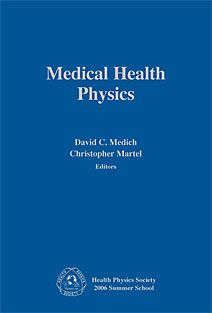
Medical Health Physics
Author: David Medich, Christopher Martel (Health Physics Society)ISBN: 9781930524316
Published: 2006 | 378 pp. | Softcover
Price: $ 75.00
Interactions | October 2006
This text begins with a brief overview regarding the practicalities of conducting a radiation protection program at a medical institution. While focused upon the regulatory environment specific to the United States, the astute reader will glean valuable insights applicable to other jurisdictions as well. Chapter 2 provides a rudimentary introduction to the basics of patient related dosimetry encountered in the field of diagnostic imaging. The unfortunate use of outdated units such as "rem" and "Rad" in this chapter and throughout the remainder of the book serves to detract from its didactic impact. Chapters 3, 4 and 5 provide basic reviews covering diagnostic radiographic equipment, Nuclear Medicine instrumentation with an emphasis on PET, and brachytherapy respectively. Particularly useful is the provision of brief subsections in chapter 3 covering history, operating principles, prevalence of use, utilization, principles of evaluation, shielding considerations, patient dosimetry, and other pertinent factors for each modality. The emphasis given to PET in Chapter 4 is warranted due to its increasing clinical importance. Chapter 6 presents a brief but useful introduction to practical aspects of licensing with regard to the use of radioactive materials. Of particular interest are some insightful recommendations concerning the manner in which a license application should be worded. Chapter 7 covers many of the issues that a medical physicist may expect to encounter when participating in medical research. The role of the medical physicist in handling incidents of misadministration is explored in Chapter 8. Several examples along with corrective actions are provided. Chapter 9 provides a brief introduction to the issue of source tracking which has attracted considerable attention in the wake of the September 11 terrorist actions in the U.S. The subject of radioactive waste management is examined in Chapter 10 and covers topics ranging from staffing requirements to the disposal of radioactive sources. Also included at the end of this chapter are a number of appendices for easy reference containing exerts from the regulations of the U.S. Nuclear Regulatory Commission (NRC). A timely review of medical laser safety is presented in Chapter 11. Shielding considerations are the focus of Chapters 12 and 13. The calculation of transmission factors for primary, scattered and leakage radiation barriers specific to diagnostic energies is covered in Chapter 12 while a brief treatment of door and maze shielding for high energy accelerators is presented in Chapter 13. Dealing with a radiation related emergency is dealt with in Chapter 14. A reflection of the time in which Americans find themselves living, the focus here is upon preparedness for the aftermath of a terrorist action involving the detonation of "dirty bomb" or radiological dispersion device. Unfortunately, only passing mention is made of incidents such as radioactive spills and accidental exposures which medical physicists will more likely have to deal with in the course of their careers. Safety audits are the subject of Chapter 15 and this subject is covered from the perspective of a U.S. regulatory inspector. Practical suggestions with regard to preparations for a safety audit are presented in Chapter 16. A concise and well balanced review of the basics of radiation health effects is provided in Chapter 17. A brief overview of the management of an effective radiation safety program rounds out this volume with numerous practical tips for an RSO.
This text provides a good basic introduction to the subject of health physics which will be helpful to those new to the field. Particularly useful are the numerous references provided at the end of each chapter which render this book a valuable reference volume.
Reviewed by Don Robinson, Ph.D.


